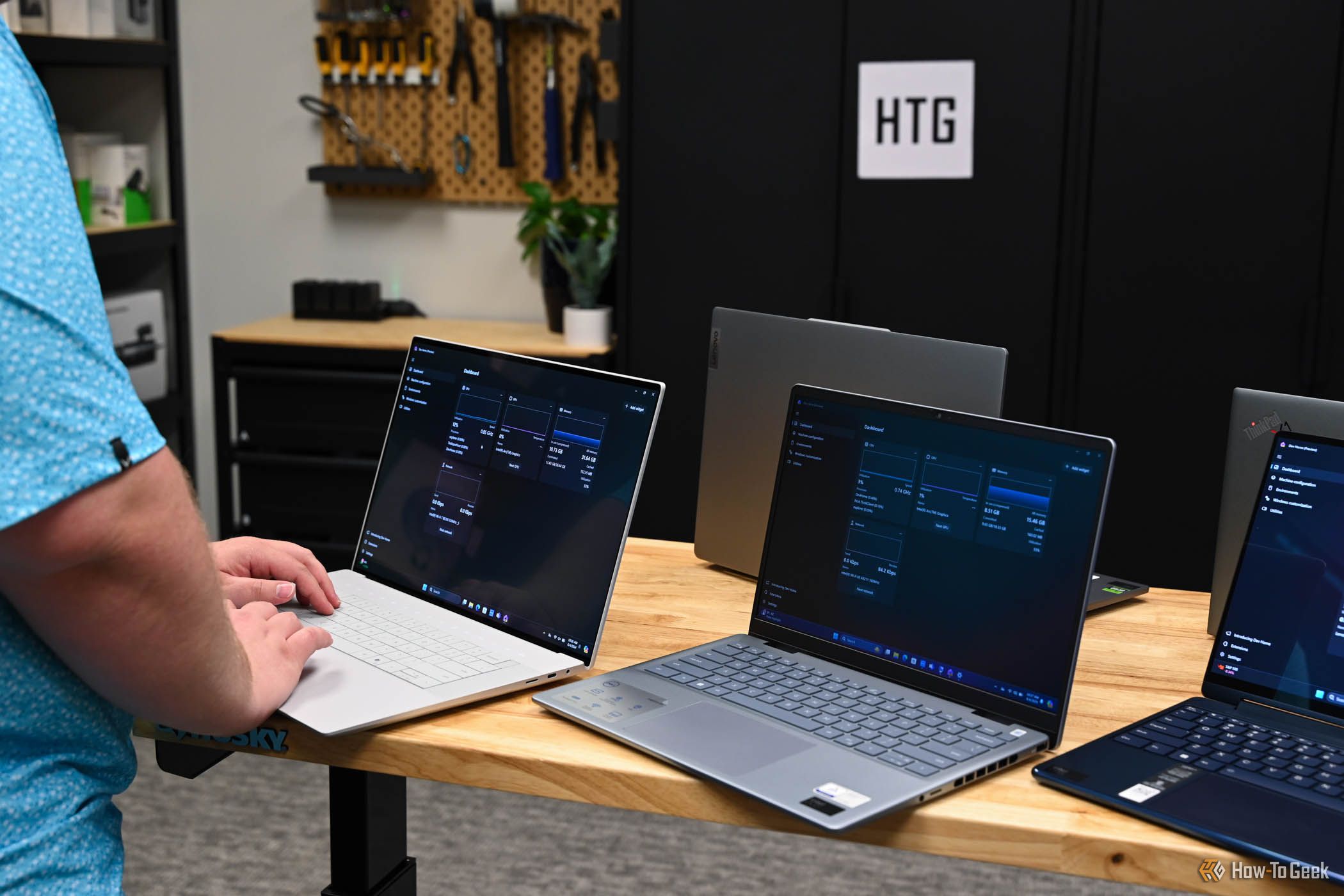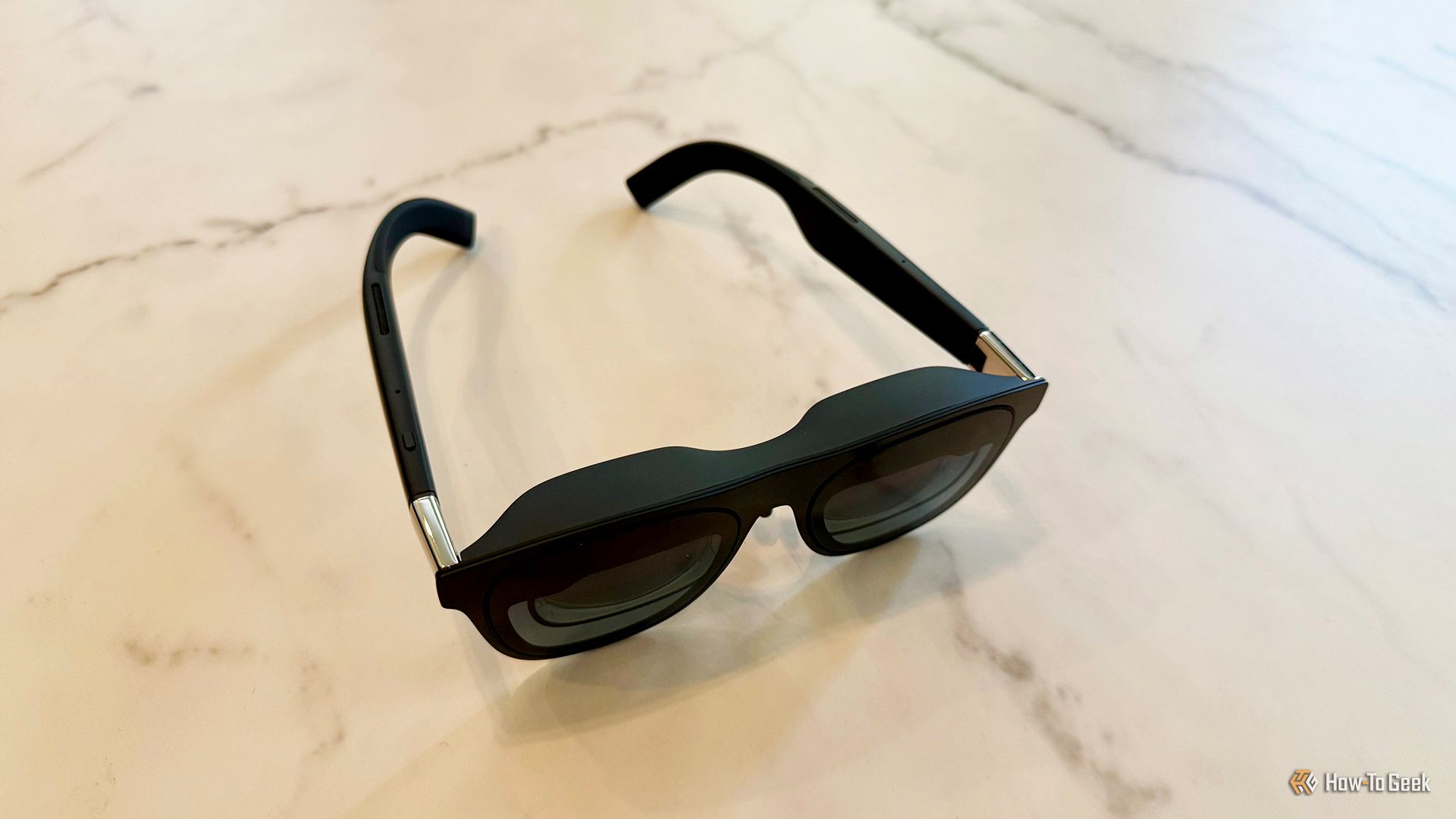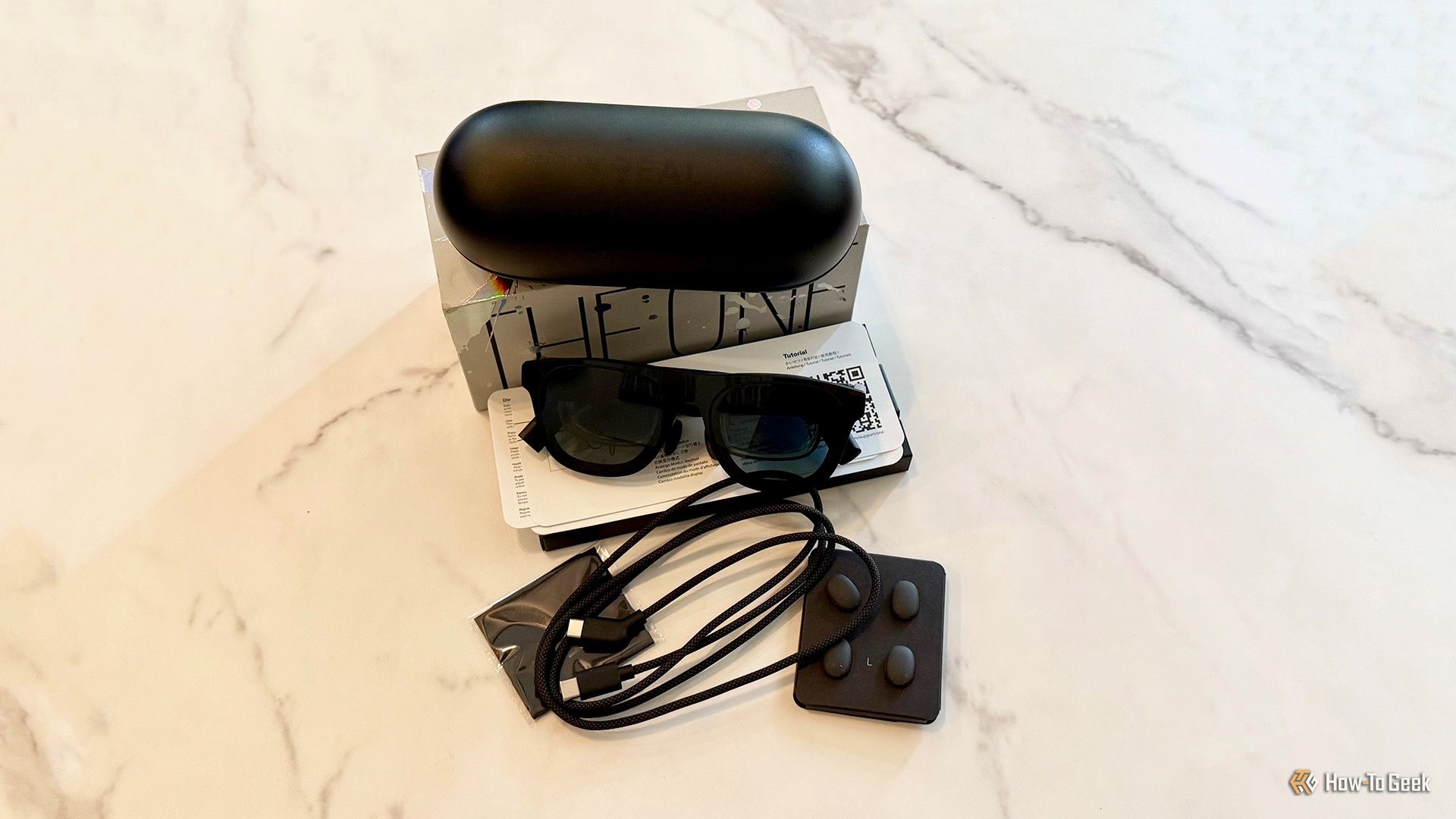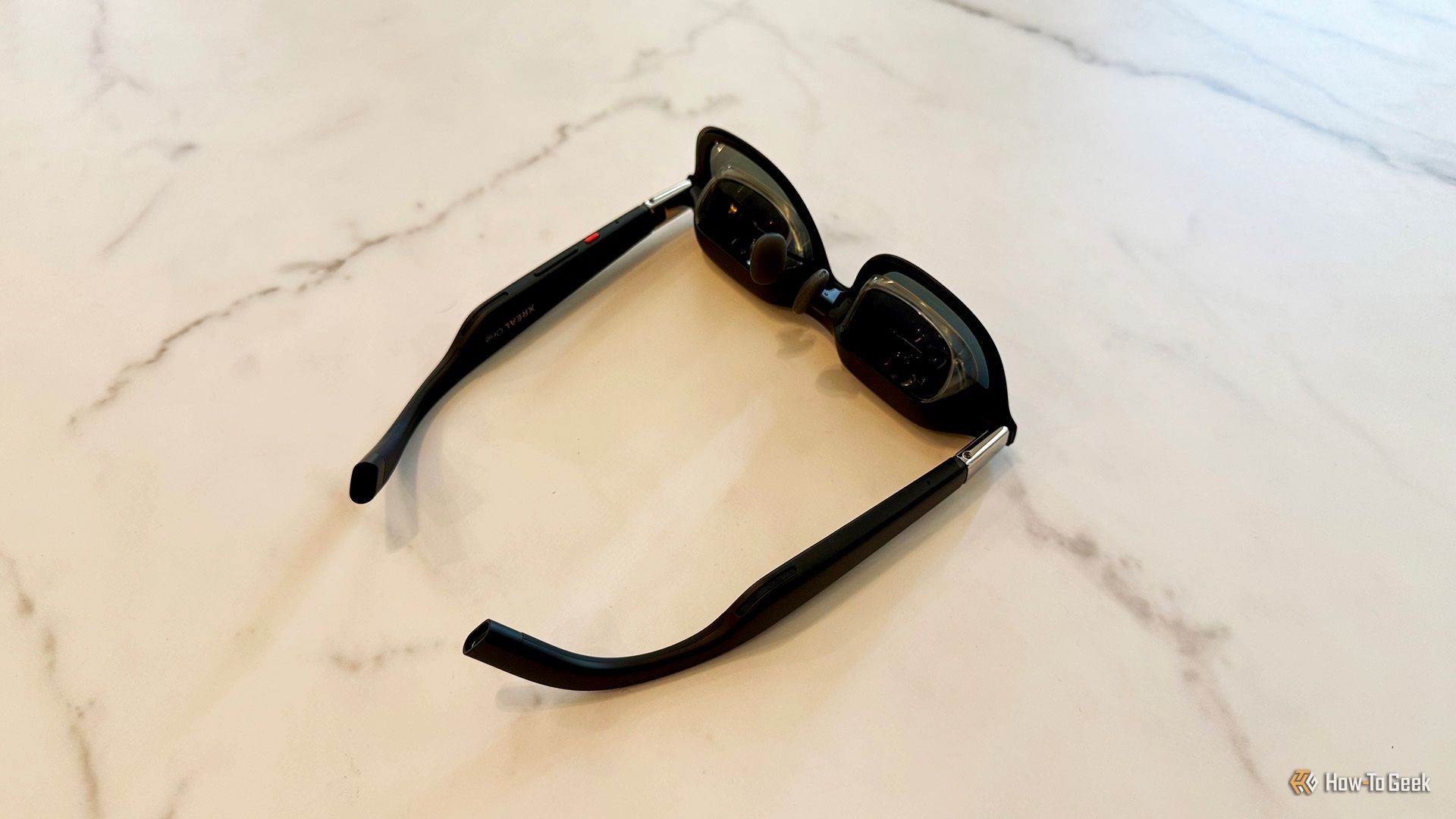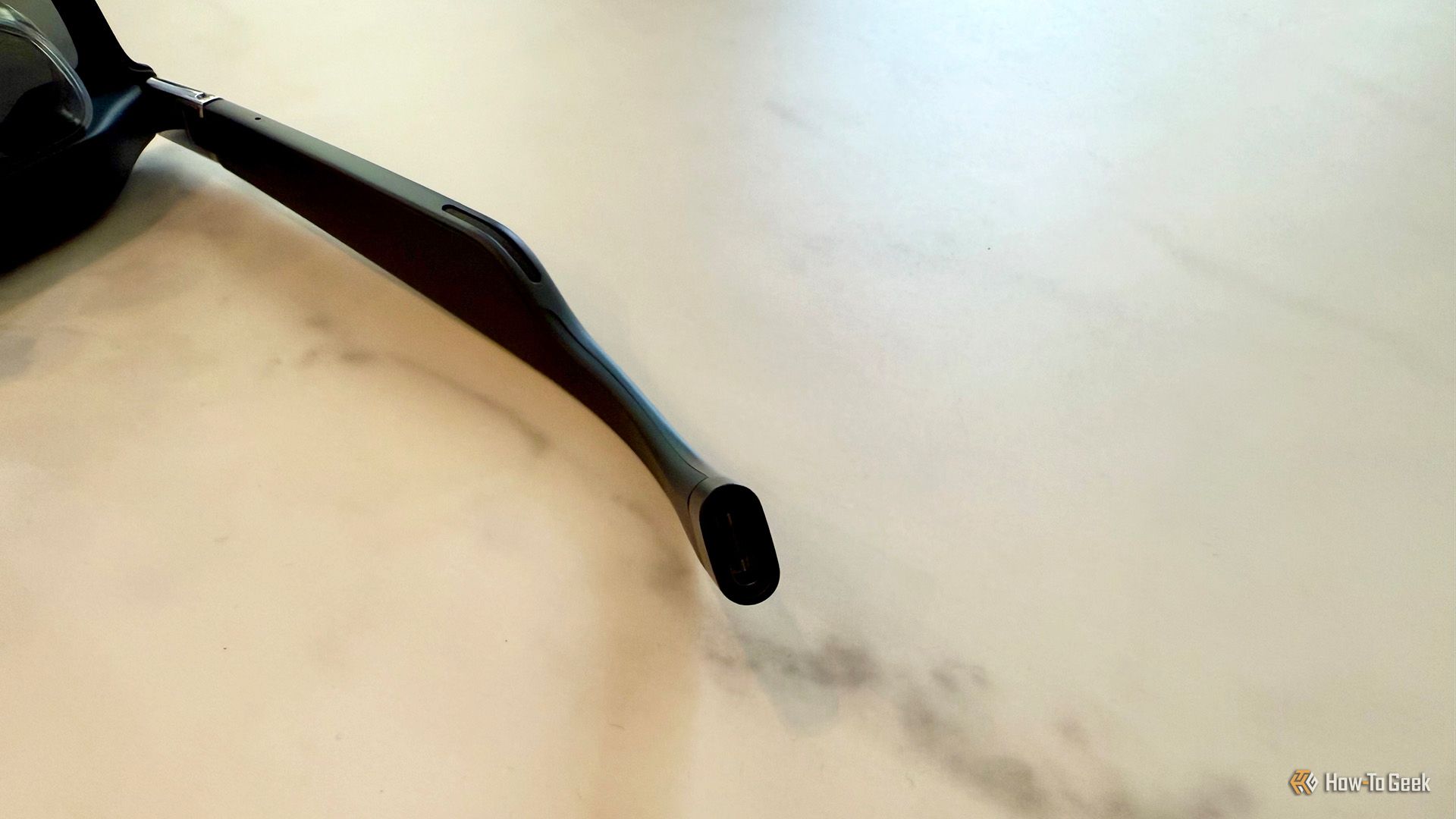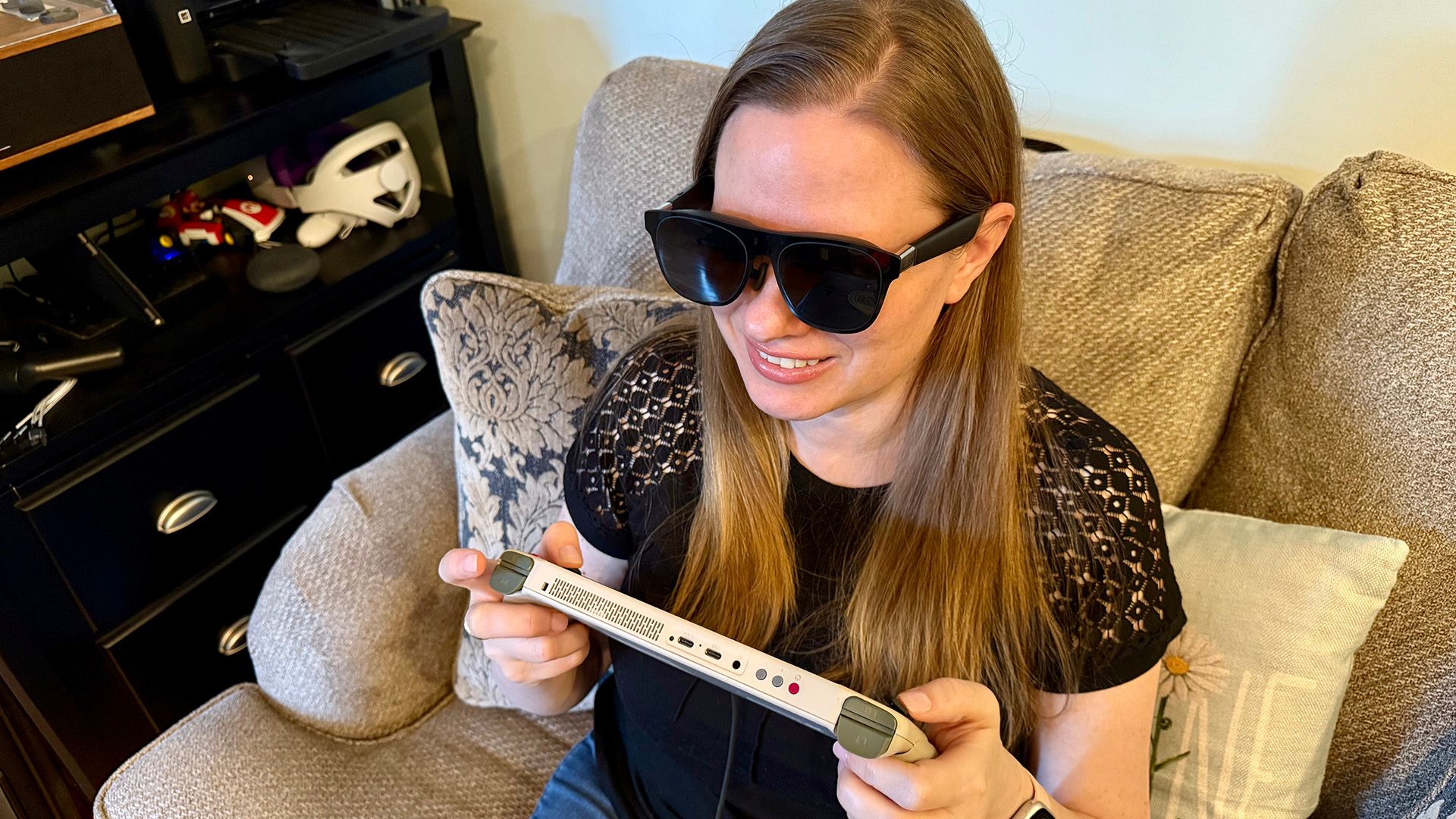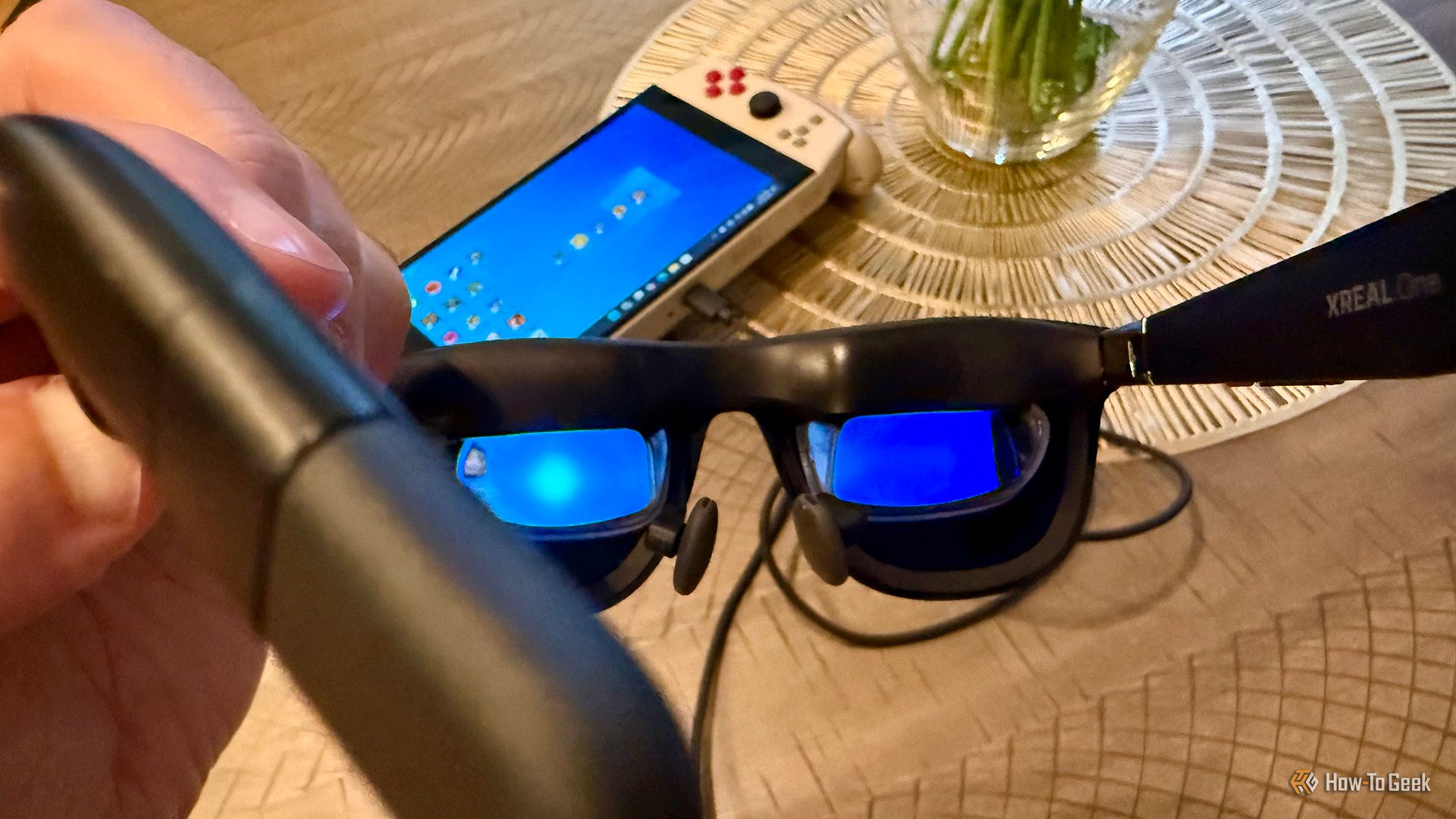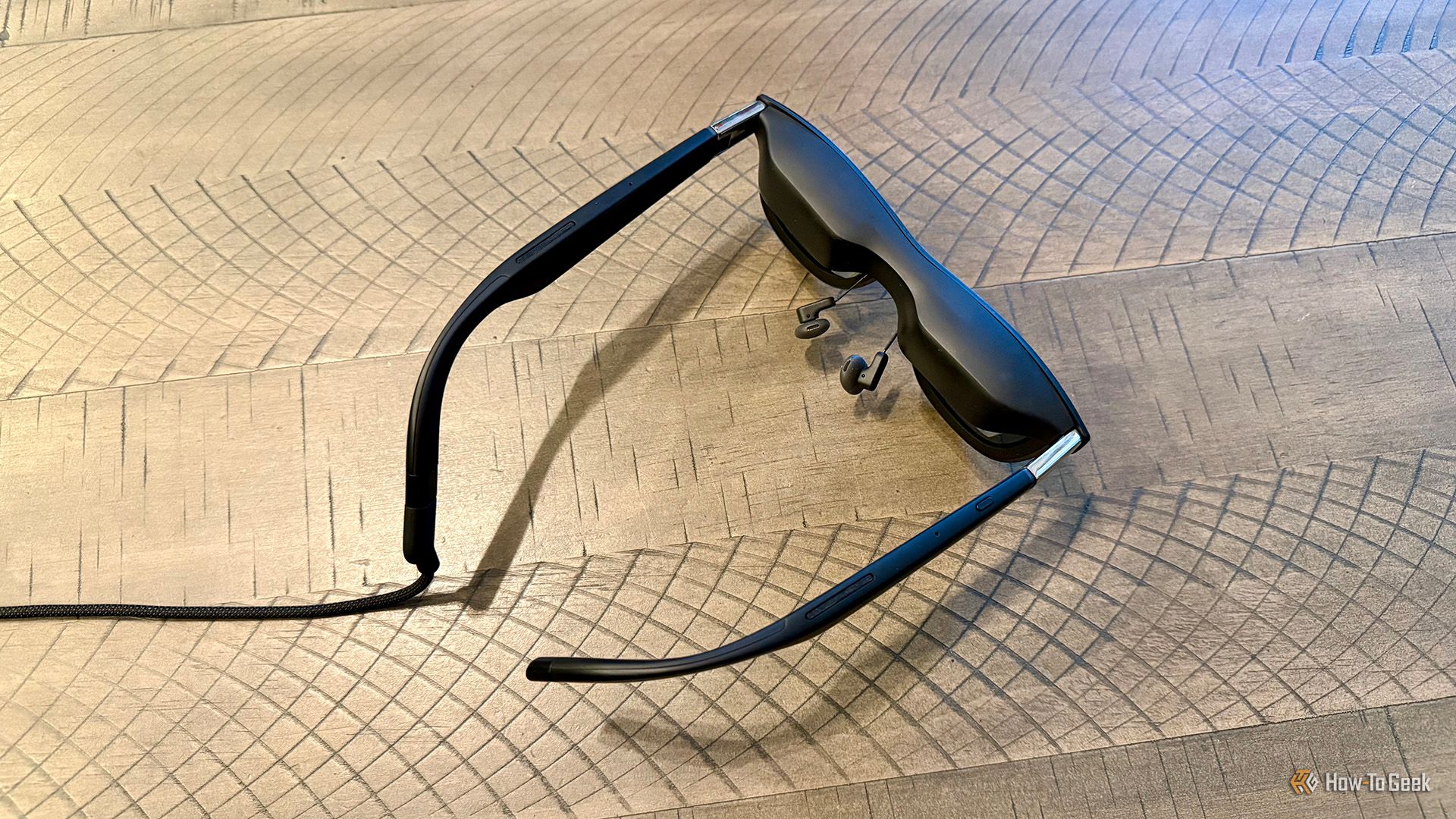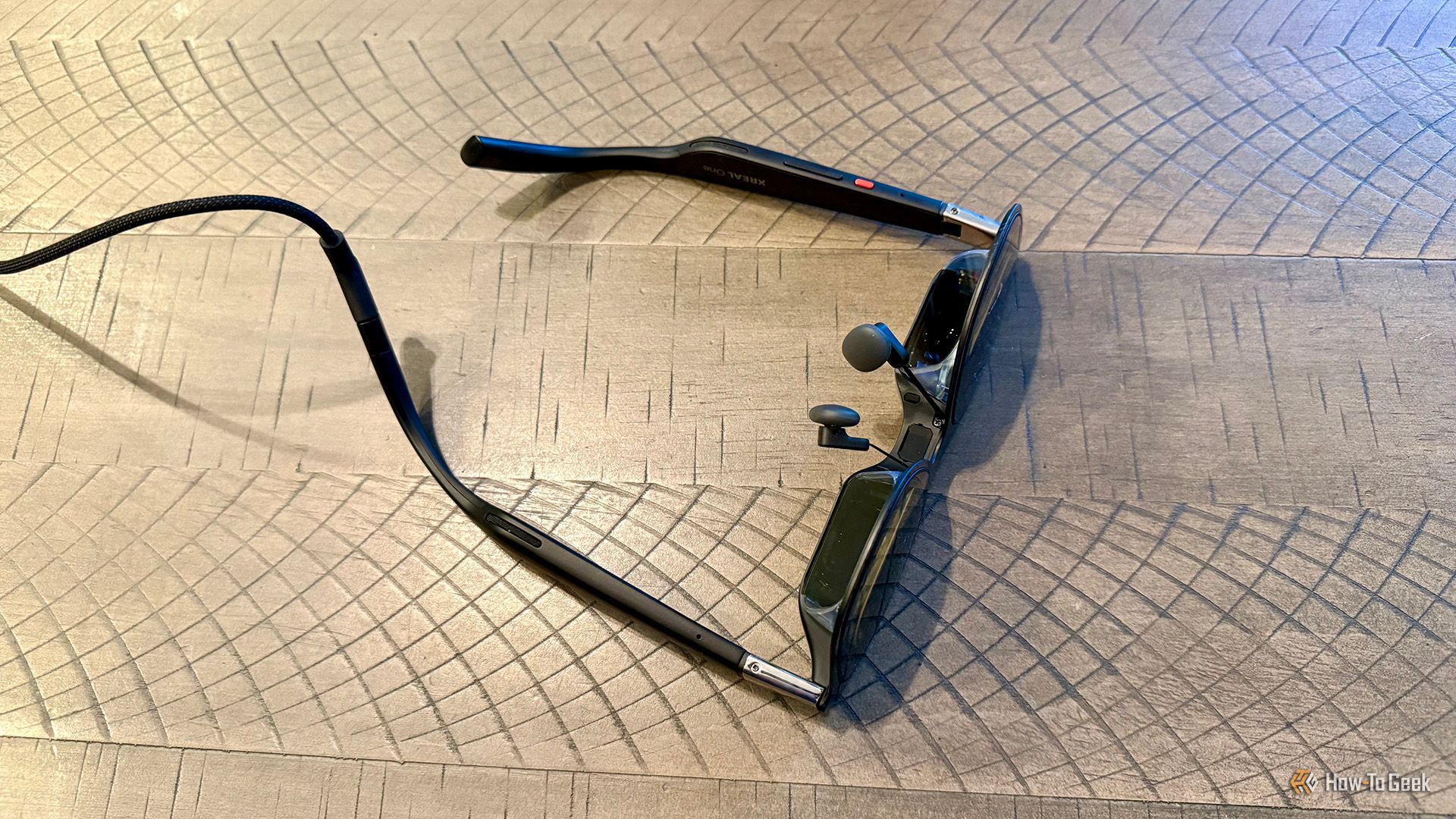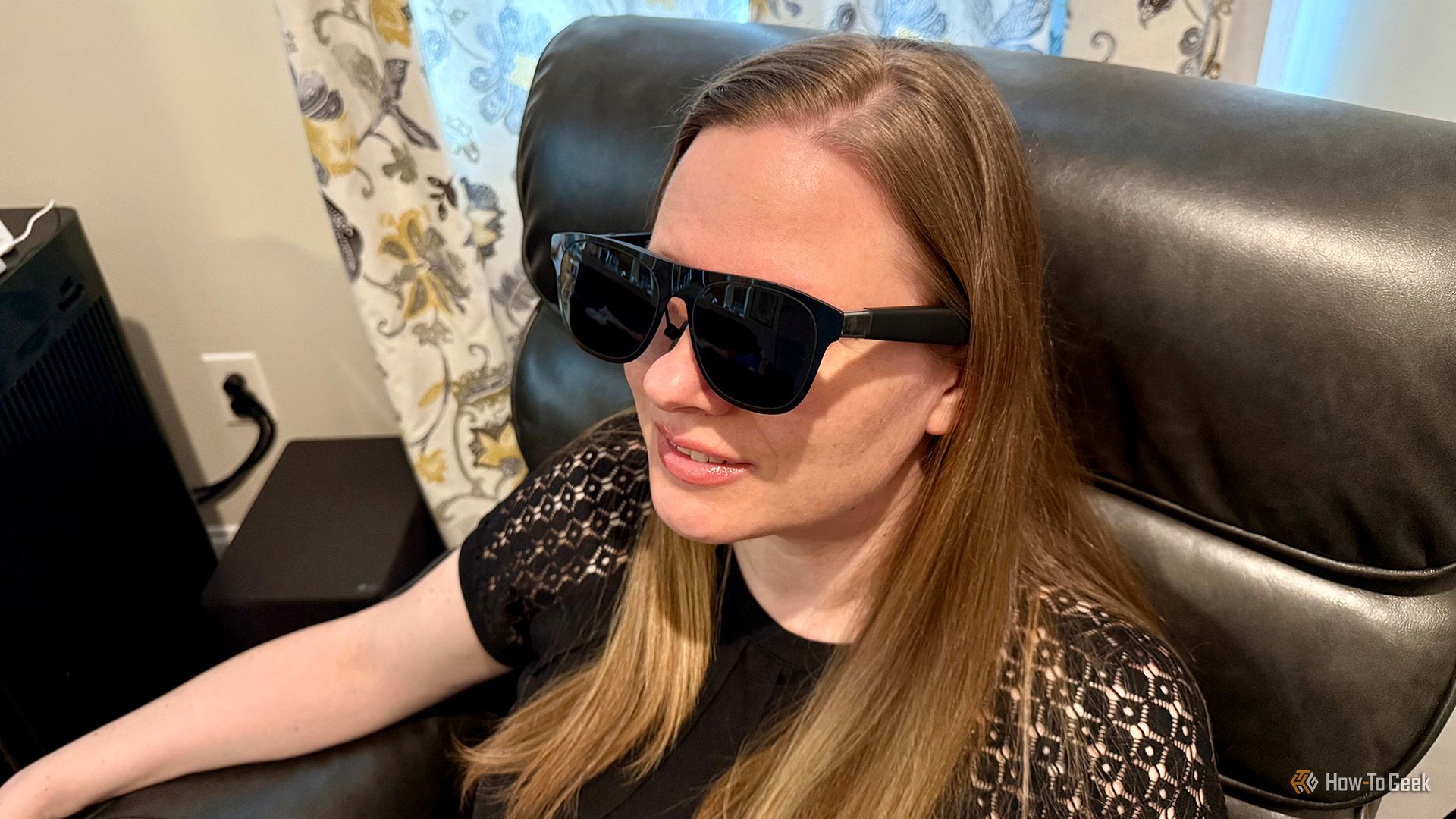Summary
- XREAL One AR Glasses deliver a 147-inch virtual display, but with a somewhat limited field of view and connectivity.
- The glasses are compatible with a wide variety of devices via USB-C, though other accessories may be necessary.
- Excellent video quality, straightforward form and functionality, and competitive features make XREAL One a valuable wearable display.
The XREAL One AR Glasses deliver a 147-inch virtual display in a go-anywhere form factor. While the field of view, out-of-box connectivity, and user interface are somewhat limited, the excellent portable big-screen video quality makes up for it.

- Speakers
-
Yes, 3.0 Spatial Sound Field
- Display
-
Sony 0.68-inch microOLED
- Refresh rate
-
120Hz
- Resolution
-
1,920 x 1,080
The XREAL One AR Glasses provide a 147-inch virtual screen, high refresh rate, spatial sound, and three degrees of freedom.
- Quality virtual display
- Plug and play with some devices
- Good audio
- Built-in microphones
- Need adapters and extra cables for some devices
- Field of view can feel limiting
Price and Availability
The XREAL One AR Glasses are available from Amazon or direct from XREAL. In the box are the glasses, a USB-C to USB-C cable, different sizes of nose pads, a cleaning cloth, a hard glasses case, and paperwork.
If you wear glasses, XREAL partners with HONSVR for snap-on prescription lenses. Details are available on the XREAL website.
- Resolution
-
1,920 x 1,080
- Refresh rate
-
120Hz
- Max brightness
-
600nits
- Field of view
-
50 degrees
- Speakers
-
Yes, 3.0 Spatial Sound Field
- Microphone
-
Yes, Dual
Functionality and Form: Relatively Straightforward
The XREAL One AR Glasses are compatible out-of-the-box with any USB-C device capable of both DisplayPort (DP) video and power output. These devices include recent Apple iPhones and iPads, most Android-based smartphones and tablets, PC gaming handhelds like Valve’s Steam Deck, and most modern laptops, including Apple’s MacBook series and various Windows-based machines.
For most of these use cases, you just plug in the included USB-C cable into the port on the rear of the left glasses arm, or temple, plug the other end of the USB-C cable into your compatible device, then you’ll shortly see the mirrored display in the glasses. From there, you can adjust various settings to your liking directly from the glasses.
There’s not much to setting up the glasses for your head and nose. The chunky glasses temples have a fixed length with some flex to accommodate wider head sizes. The temples can also be shifted up or down into one of three positions, with a click, to help with the viewing angle.
Pre-installed are the medium nose pads, but there are also sets of small and large. It’s not especially difficult to slide the nose pads on or off, but I couldn’t help but feel that it’s a fragile area that might not hold up to frequent swaps for different users.
With that said, there’s not necessarily a huge difference between the nose pads. It’s more in how the glasses sit on your face and how much of the virtual display you get to see without, in particular, the bottom of your video being cut off.
For me, I found both the small and large nose pads better than the medium, and eventually settled on the large, which is supposed to be suitable for low nose bridges. These pads, along with shifting the temples into their highest position, allowed the glasses to sit right up against my face so I could take in the full breadth of the virtual display without having to shrink it, at least when viewing landscape content.
The IPD, or Inter-Pupillary Distance, which is the distance between the center of a person’s pupils, is adjusted from the onboard user interface. The XREAL One’s default is 64.5mm (0), with a range of 59.5mm to 70.5mm, which should accommodate the needs of most users. I was fine with the default IPD since the outer edges of the display remained sharp within my field of view.
The glasses have a mix of shiny and matte black finishes. These do tend to attract face oils, so it’s a good idea to wipe your face before use if you’re a bit on the shiny side, like me. The included XREAL-branded microfiber cloth, or any other quality microfiber cloth for that matter, does a good job of keeping the lenses clean.
Controlling the glasses with the onboard buttons is relatively straightforward. Unfortunately, these controls suffer from some of the same frustrations that traditional monitor user interfaces have by cramming too many functions into too few buttons.
There are a total of four buttons on the XREAL One. The red button, referred to as the X button, is located under the right temple, near the front. A single press changes the display mode between fixing the display in one location, Anchor, or having it follow where your head moves, Follow. A double press brings up the screen menu, where you can then use the plus and minus buttons to navigate the menu options, with X to confirm.
The plus and minus button bar is also located under the side of the right temple, just behind the X button. A single press increases or decreases the screen brightness, respectively. A long press increases or decreases the electrochromic level, respectively, with level one only dimming the outside world view slightly and level three going full blackout.
The fourth and final button is located on the top of the right temple, directly opposite the X button. A single press switches to transparency mode, which allows you to turn off the electrochromic effect and display to see the outside world through the glasses.
Fortunately, I didn’t find the need to adjust most of the settings on a regular basis. Again, it’s a functional user interface with quite a few options using just the X and button bar. Still, it would have been nice to have an app or some other way to configure the various options that are at deeper menu levels, like screen size adjustments, and then have them remain persistent. I also found it a bit too easy to hit some of the buttons by accident when I grabbed the sides of the glasses.
Display, Sound, and Performance: Effective Quality
The XREAL One uses Sony MicroOLED displays with up to 600 nits of brightness and a speedy 120Hz refresh rate. Although a resolution of 1,920 x 1,080, or 1080p, per eye, isn’t much in an increasingly 4K world, I never once felt the display was lacking, as it had excellent color reproduction and sufficient clarity to make even small text easily readable.
One area of the display where I would have liked more was the field of view, or FOV, which is 50 degrees. While this visible area is indeed enough to simulate a 147-inch screen when viewing widescreen 16:9 content, I couldn’t help but feel a bit cramped to the left and right, particularly in Anchor mode. In fact, XREAL recommends setting the screen slightly smaller than the FOV edge, down to 117 inches, when in Anchor mode, to avoid any part of the screen being cut off.
Fortunately, although you’ll have to dig a bit in the menu, you can adjust both the screen size and screen distance to your liking. You can set the FOV to as low as 80% for a 117-inch virtual screen at a 4m/inch distance, all the way up to a 120% FOV for a 440-inch virtual screen at a 10m/inch distance.
Speaker quality is surprisingly good for sitting just above your ears rather than in. The audio profile is a bit flat with some tinniness, but it’s pleasant enough to listen to music or movies. Even at the highest volume levels, sound remains clear and easy to distinguish with solid stereo separation.
As expected, at the highest volume levels, the sound does spill out, so it’s less-than-private listening. At lower volume levels, another person would have to be pretty close to you to make out what you were listening to. For most XREAL One owners, especially given how relatively private the display itself is, a good pair of Bluetooth headphones remains the smarter choice for both privacy and sound quality.
The XREAL One has built-in microphones at the top rear of the temples, just before the bends. The quality of the microphones is surprisingly good. While there’s not a lot of presence to the audio it captures, it’s clear, with decent background noise isolation. I wouldn’t hesitate to use these microphones for a phone call or casual recordings.
For regular usage, be it watching videos, playing games, or even as a private computer display, the XREAL One delivers, particularly with native 16:9 widescreen content. However, there are three additional modes that further add to the XREAL One’s value: Ultra-Wide Mode, Side View Mode, and 3D mode.
Ultra-Wide Mode provides a virtual 3,840 x 1080 display on devices, like laptops, that support extended displays. You’ll have to move your head left and right to take in the entirety of the display, and it’s nowhere near as good as a real ultrawide monitor, but it’s an easy way to create a larger workspace.
Side View Mode is designed to allow you to focus on the display while performing other tasks. For instance, you can place the virtual display on the top left side of the screen while the rest of your FOV is completely transparent to the outside world. This is a great way to, for instance, watch YouTube videos while enjoying a meal, with nary a spill.
The 3D Mode is arguably the most intriguing, but one I found a bit disappointing. As long as your device outputs 16:9, you can watch Full or Half Side-by-Side (SBS) 3D videos up to a resolution of 3,840 x 1,080. Unfortunately, whether using, for example, YouTube 3D content or content I supplied myself via the VLC app, I found there was little wow factor in the 3D effect, with it mostly limited to providing inward depth rather than anything that seemed to pop out of the screen towards me.
While the overall quality, features, and price point of the XREAL One are competitive with similar products like the VITURE Pro XR Glasses, it’s XREAL’s own One Pro that provides a better alternative for just $100 more. The One Pro provides a larger FOV, a slightly brighter and bigger virtual screen, and better reduction of both light interference and reflections during use. They also reduce some of the bulk present in the XREAL One’s design. I never found any of these improved areas particularly lacking in the XREAL One, but there’s no denying the relative value of the One Pro.
Connectivity: You’ll Likely Want to Add Some Accessories
I had zero issues connecting my iPhone 16 Pro Max, Samsung Galaxy Tab S10 Ultra, Steam Deck, or GPD Duo Laptop to the XREAL One. It worked using the USB-C cable like any other external display and looked good doing it. Of course, there is one catch.
Since the XREAL One has no built-in battery, and just provides a single USB-C cable, it requires and draws power from the device it’s plugged into. This is fine for devices like the ones mentioned above and earlier, but it not only drains the host device’s battery faster, it also limits what it can be plugged directly into. Fortunately, there’s a solution.
A device like the XREAL Hub, or equivalent, which takes two USB-C inputs, allows you to both play and charge. Naturally, you’ll need to connect a USB-C power adapter to one input and your device to the other with a suitable cable, but it solves the problem for either poor battery life devices like the Steam Deck or something like the Nintendo Switch that only outputs video, but not power, over their USB-C ports.
A bit more involved is adapting HDMI-based devices, like the Microsoft Xbox Series X or Sony PlayStation 5 Pro. You’ll not only need a device like the XREAL Hub to supply power to the XREAL One, you’ll also need to provide an HDMI to USB-C adapter and any additional cables you might not have handy. On the plus side, with this type of setup, I had no trouble driving the XREAL One at its full 1080p 120Hz capability on both my Xbox Series X and PlayStation 5 Pro, as well as miscellaneous HDMI-based devices like the Atari 7800+ with more modest performance output.
Should You Buy the XREAL One AR Glasses?
The XREAL One AR Glasses may not be the most attractive on your face, but they don’t look too over-the-top for what they do. More importantly, they perform well for their intended task and remain comfortable even after wearing them for several hours at a time.
Whether lying in bed, on the go, or just sitting at my desk, the XREAL One was fun for entertainment purposes and usable in smaller doses for some productivity. These types of glasses aren’t cheap and most likely will require the purchase of additional accessories, but they do work well out of the box. If you don’t want to cover the extra investment required for XREAL’s own One Pro, then the XREAL One proves to be one of the better choices in wearable displays.

- Speakers
-
Yes, 3.0 Spatial Sound Field
- Display
-
Sony 0.68-inch microOLED
- Refresh rate
-
120Hz
- Resolution
-
1,920 x 1,080
The XREAL One AR Glasses provide a 147-inch virtual screen, high refresh rate, spatial sound, and three degrees of freedom.

